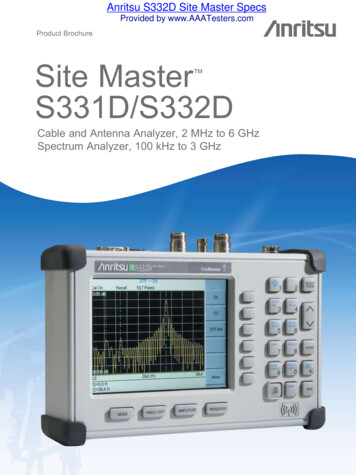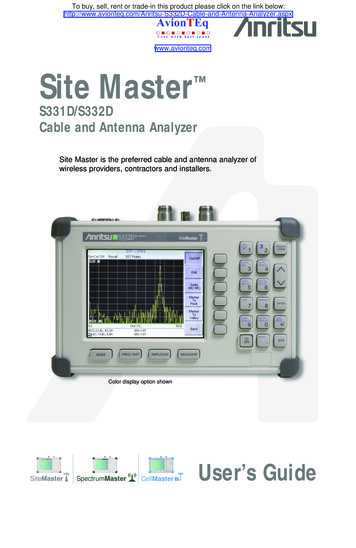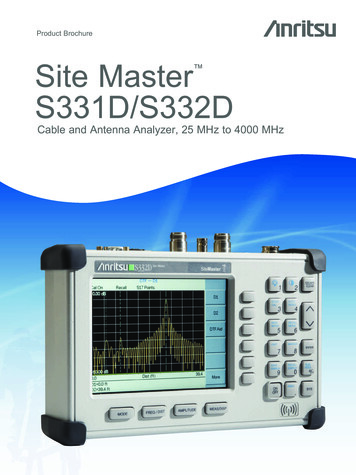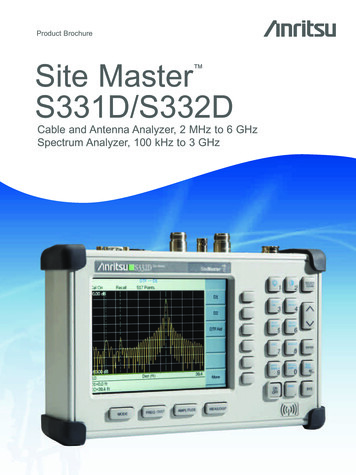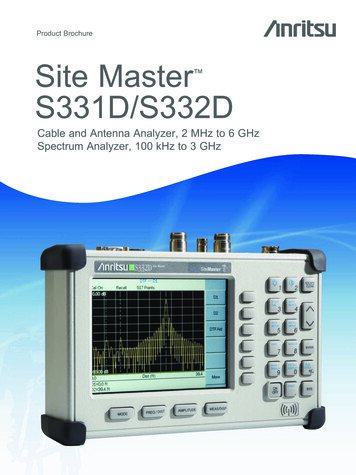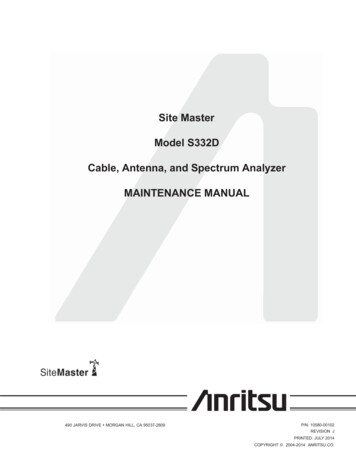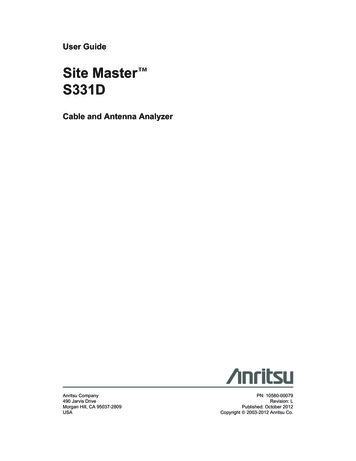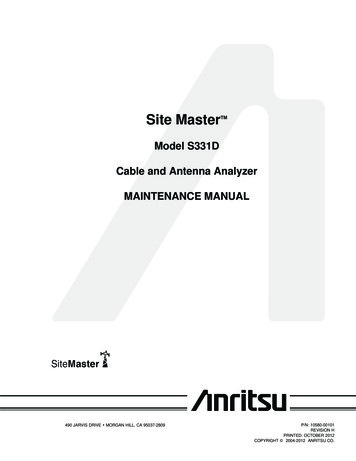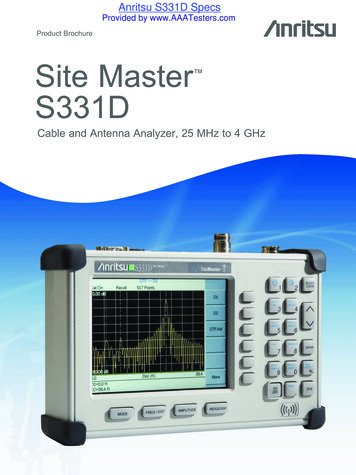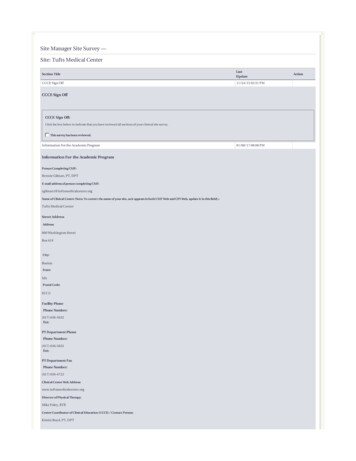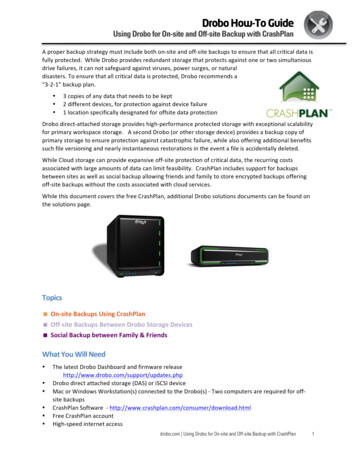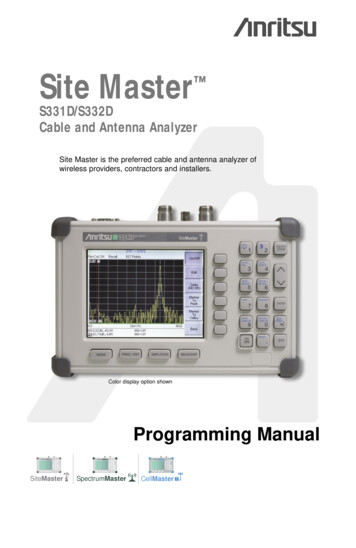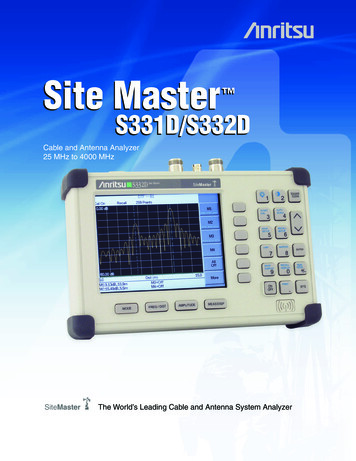
Transcription
Site Master S331D/S332DCable and Antenna Analyzer25 MHz to 4000 MHzSiteMasterThe World’s Leading Cable and Antenna System Analyzer
Site Master is the Preferred Cable and Antenna Analyzerof Wireless Service Providers, Contractors, and Installers.Cost Savings and Quality ImprovementWireless market competition requires operators to reduce per site maintenanceexpense. Site Master’s Frequency Domain Reflectometry (FDR) techniques breakaway from the traditional fix-after-failure maintenance process by finding small, hardto identify problems before major failures occur.Sixty to eighty percent of a typical cell site’s problems are caused by problematiccables, connectors and antennas. When cables or antennas are contaminated withmoisture, damaged, or mispositioned during storms, Site Master identifies theproblem quickly. Antenna degradation reduces the cell coverage pattern and cancause dropped calls. Site Master can pinpoint the antenna problem from groundlevel in a few seconds making climbing the antenna tower unnecessary.A poorly installed weather seal will corrode connectors and, if undetected, willeventually damage an expensive coaxial cable. Site Master has the sensitivity toidentify the connector problem before the cable is damaged. Distance-To-Faultprovides the clearest indication of troubled areas.Site MasterRevolutionizesCable andAntennaSweepingin the WirelessIndustry.Rugged and ReliableBecause the Site Master was designed specifically for field environments, itcan easily withstand the day-to-day punishment of field use. The analyzer isalmost impervious to the bumps and bangs typically encountered by portablefield-equipment.Easy-to-UseSite Master operation is straightforward; measurements are obtainedthrough a menu-driven user interface that is easy to use and requires littletraining. The large, and high-resolution TFT color display makes testinterpretation easy and quick. A full range of markers enable the user tomake accurate measurements. Limit lines simplify measurements allowingusers to create quick and simple pass/fail tests.Features local language graphical user interface support inEnglish, Chinese, Japanese, French, German, and Spanish.2
External DCPower PortRS-232 InterfaceTransfer stored data to and froma personal computer (PC) ordownload to a printer via a serialcable for further analysis. Use PCto automatically control and collectdata in the field.Spectrum Analyzerand Power Meter PortExternal Trigger andExternal Reference InCable and AntennaAnalyzer PortT1/E1 Receive and Transmit PortS331D Models with Option 50.Frequency Converter Module PortOption 6 (S332D) for control of anexternal frequency extension module.Snap-in Field replaceablebattery locationSave and Recall SetupSave setups for fastrepeatable testing:S332D Models - 20S331D Models - 25Rugged and ReliableChassis DesignRuggedized, lightweight,compact, high-impact housing isdesigned to withstand repeateddrops and rough handling.Weather resistant seals andrubber membrane keypadprotect unit from dirt andmoisture.MarkersSix markers for morecomprehensive measurements.LimitsCreate simple pass/failmeasurements with a single limitline, upper and/or lower masklimit lines.Multilingual User InterfaceMulti-language user interfacefeatures on-screen menus andmessages in six differentlanguages: Chinese, English,French, German, Japanese,Spanish.TFT Color DisplayStandard TFT (640 x 480) colordisplay featuring variablebrightness control.Viewable in direct sunlight.Function KeysFour dedicated function keys simplifymeasurement tasks.Soft KeysIntuitive soft key menuand user interface.Save and Recall DisplayUp to 200 memory locations.Alphanumeric data labelingand automatic time/date stampsimplify data management.AM/FM Receiverwith Internal SpeakerBuilt-in AM/FM demodulatorenables testing and troubleshooting of wirelesscommunications systems.An internal speaker and jack areincluded.FunctionBenefitsCable and Antenna Analyzer (331D/S332D)Characterize antenna system and pinpoint location of faultsSpectrum Analyzer (S332D)Easily locate, identify and record various signals with high accuracyAM/FM Demodulator (S332D)Built-in demodulator for AM, narrow band FM, wide band FM, and SSB allows technician tolisten to and identify interfering signalsStandard TFT Color Display (S331D/S332D)Display is viewable in direct sunlightPower Monitor (S331D/S332D)Performs accurate broadband power measurements using an external detectorFrequency Converter Interface (S332D)Make measurement from 4.7 to 6 GHz using an external detectorBuilt-in 12 to 24V variable Bias Tee (S332D) No need to use external power to bias an amplifierTransmission Measurement (S332D)Identify and locate interfering signals that cause dropped calls and coverage problems.Intermittent problems can be identified using spectrogramsInterference Analyzer (S332D)Identify and locate interfering signals that cause dropped calls and coverage problems.Intermittent problems can be identified using spectrogramsChannel Scanner (S332D)Measure frequency, bandwidth and power of multiple transmitted signalsCW Signal Generator (S332D)CW source to test low noise amplifiersPower Meter (S331D/S332D)Performs accurate power measurements up to 3 GHz without the need of an external detectorGPS Receiver (S331D/S332D)Provides location (latitude, longitude, altitude) and UTC time informationT1/E1 Analyzer (S331D)Simplifies the task of determining if the source of problems is on the wireline or the wireless side3
Cable and Antenna Analysis – Increase System UptimeFDR TechniqueFrequency Domain Reflectometry, (FDR), and Time Domain Reflectometry, (TDR), have similar acronyms, and bothtechniques are used to test transmission lines. But, that’s where the similarities end. TDRs are not sensitive to RF problems:the TDR stimulus is a DC pulse, not RF. Thus, TDRs are unable to detect system faults that often lead to system failures.Additionally, FDR techniques save costly, time-consuming trouble shooting efforts by testing cable feed-line and antennasystems at their proper operating frequency.Deficient connectors, lightning arrestors, cables, jumpers, or antennas are replaced before call quality is compromised.Quick, Simple MeasurementsSite Master performs various RF measurements aimed at simplifying cable feedline and antenna analysis: Return Loss,SWR, Cable Loss and Distance-to-Fault (DTF). A single key selection on the main menu activates the desired measurementmode.Return Loss, SWRReturn Loss and SWR “system" measurements ensure conformance tosystem performance engineering specifications. Measurement easily togglesbetween either one of the two modes and can be performed without climbingthe tower.Cable LossCable Loss measurements measure the level of insertion loss within the cablefeed-line system. Insertion loss can be verified prior to deployment, when youhave access to both ends of the cable, or on installed cables without access tothe opposite end. Site Master automatically calculates and displays the averagecable loss so there is no more guess work or a need to perform calculations inthe field.Distance-to-FaultAlthough a Return Loss test can tell users the magnitude of signal reflections,it cannot tell the precise location of a fault within the feed-line system.Distance-To-Fault measurements provide the clearest indication of troubleareas as it tells us both the magnitude of signal reflection and the location ofthe signal anomaly.Distance-To-Fault measurement capability is built into all Site Master models asa standard feature. Return Loss (SWR) measurement data is processed usingFast Fourier Transform and the resulting data indicates Return Loss (SWR)versus distance. Distance-to-Fault measurements indicating Return Loss orSWR versus time is available with Handheld Software Tools .4
OSL CalibrationOpen-Short-Load (OSL) calibration is standard for the S331D and S332D. All errors from source match, directivity andfrequency response are mathematically removed allowing for accurate vector corrected Return Loss, Cable Loss, VSWR,and DTF measurements. Directivity is usually the main contributor to measurement uncertainty, and corrected directivityof 42 dB or better is common using Anritsu’s precision components.FlexCal The Site Master FlexCalTM broadband calibration feature is an OSL-based calibration method. It offers field technicians asimple and convenient way to troubleshoot and identify faulty antenna system components, because it eliminates the needfor multiple instrument calibrations and calibration setups. Field technicians can now perform a broadband calibrationfrom 25 MHz to 4 GHz and change the frequency range after calibration without having to recalibrate the instrument. Azoom-in/zoom-out capability is available in Return Loss, Cable Loss or VSWR mode. Because the resolution and maximumdistance are dependent on the frequency range, field technicians can even change the frequency range in DTF mode toproduce the desired fault resolution and horizontal range needed for the measurement, without performing additionalcalibrations.InstaCal CalibrationThe InstaCal Calibration module is available for the S331D and S332D and users can cut the timerequired to calibrate the Site Master by as much as 50 percent. With InstaCal, users areonly required to connect the InstaCal calibration module once and thecalibration process will be done automatically. Directivity specification for theInstaCal module is 38 dB for the entire frequency range allowing the user tomake fast and accurate measurements.RF ImmunityIn today’s wireless environment it is very common that there will be other RF activity present when making a measurement.In order to make accurate measurements in hostile RF environments, the receiver has to be able to reject the unwantedsignals. Special dithering techniques are applied to the Site Master when making a measurement, and the Site Master canreject signals up to 17 dBm ensuring accurate measurements in RF rich environments.5
Spectrum Analysis – Anywhere, Anytime (S332D)The Site Master S332D integrated Spectrum Analysis capability provides the “ultimate” in measurement flexibility forfield environments and applications requiring mobility. With the S332D you can locate, identify, record and solvecommunication systems problems quickly and easily, and with incredible accuracy – making it a perfect solution forconducting field measurements in the 100 kHz to 3 GHz frequency range.One Button MeasurementsThe S332D has dedicated routines for one-button measurements of field strength, channel power, occupied bandwidth,Adjacent Channel Power Ratio (ACPR), Carrier-to-Interference, and interference analysis. These are increasingly criticalmeasurements for today’s wireless communication systems. The simple interface for these complex measurementssignificantly reduces test time and increases analyzer usability.Occupied BandwidthThis measurement calculates the bandwidth containing the total integratedpower occupied in a given signal bandwidth. There are two different methodsof calculation depending on the technique used to modulate the carrier. Theuser can specify percent of power or the “x” dB down point, where “x” can befrom 1 dB to 120 dB below the carrier.Adjacent Channel Power RatioA common transmitter measurement is that of adjacent channel leakage power.This is the ratio of the amount of leakage power in an adjacent channel to thetotal transmitted power in the main channel. This measurement is used toreplace the traditional two-tone intermodulation distortion (IMD) test for systemnon-linear behavior.The result of an ACPR measurement can be expressed either as a power ratio ora power density. In order to calculate the upper and lower adjacent channelvalues, the S332D allow the adjustment of four parameters to meet specificmeasurement needs: main channel center frequency, measurement channelbandwidth, adjacent channel bandwidth and channel spacing. When an airinterface standard is specified in the S332D, all these values are automatically setto the normal values for that standard.AM/FM/SSB DemodulatorA built-in demodulator for AM, narrowband FM, wideband FM and single sideband(selectable USB and LSB) allow a technician to easily identify interfering signals.6 GHz MeasurementsThe FCN4760 is a block down converter for the 4.7 to 6.0 GHz frequency range.It is designed to work with an Anritsu Site Master S332D equipped with Option 6.This converter is primarily intended for field use by fixed wireless engineerswho are responsible for the design, deployment and optimization of 802.11anetworks. It is also used to conduct interference analysis measurements todetermine the level of interference and locate the sources of interference.6Frequency ConverterControl Module
Site Master OptionsPower Monitor (Option 5, S331D andS332D)Use Anritsu’s 560 and 5400 series detector to measurebroadband power. They are an excellent solution to measure an18 GHz microwave link carrying the Base Station T1/E1 link.The detectors use precision high return loss detectors withexcellent impedance match designed to minimize mismatchuncertainty (See uncertainty curves on page 11). Measurementrange is from –50 to 16 dBm and the display range is from–80 to 80 dBm. There are several detectors available designedfor different frequency ranges.Frequency Converter Control Module Interface(Option 6, S332D)Connector providing internal control signals to work with the FCN4760, a block down converter designed forthe 4.7 to 6 GHz frequency ranges (see page 6).Built-in Bias Tee (Option 10A, S332D)Built-in power supply can be turned on as needed to place 12 to 24V (variable in 1V steps) on the center conductorof the RF In port. It is designed to deliver 6W steady state.Transmission Measurement (Option 21, S332D)Built-in signal source from 25 MHz to 3 GHz provides the capability to make2-port measurements and measure gain, loss, or isolation of devices such asfilters, cables, attenua
It is designed to work with an Anritsu Site Master S332D equipped with Option 6. This converter is primarily intended for field use by fixed wireless engineers who are responsible for the design, deployment and optimization of 802.11a networks. It is also used to conduct interference analysis measurements to determine the level of interference and locate the sources of interference. 6
